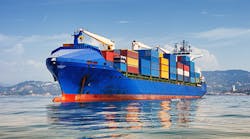Imports at the nation’s major retail container ports are expected to hit their highest level of the year again next month just before more tariffs take effect in December, according to a recent report from the National Retail Federation and Hackett Associates.
“This is the last chance to bring merchandise into the country before virtually everything the United States imports from China comes under tariffs,” NRF vice president for Supply Chain and Customs Policy Jonathan Gold said.
“Retailers are doing all they can to mitigate the impact of tariffs on their customers,” added Gold. “The effect on prices will vary by retailer and product during the holiday season, but ultimately these taxes on America businesses and consumers will result in higher prices. We urge the administration to use this week’s talks with China to make progress toward ending the trade war and return to policies that promote long-term economic growth and prosperity for American families.”
New 15% tariffs on a wide range of consumer goods from China took effect at the beginning of September and are scheduled to be expanded to additional goods on December 15 – covering a total of about $300 billion in imports.
In addition, 25% tariffs on $250 billion worth of imports already imposed over the past year are scheduled to increase to 30% on October 15.
“Let there be no doubt, U.S. trade policies and enforcement mechanisms have directly caused a global slowdown in economic growth,” Hackett Associates Founder Ben Hackett said. Nonetheless, imports are continuing to grow as retailers bring merchandise into the country ahead of tariffs. “The strength of retail consumption will push any meaningful slowdown in imports into next year, when the full impact of the tariff wars will be translated into a consumption tax felt by consumers.”
U.S. ports covered by Global Port Tracker handled 1.97 million Twenty-Foot Equivalent Units in August, the latest month for which after-the-fact numbers are available. That was up 0.2 percent from July and up 3.9% year-over-year, and was the second-highest number of containers imported during any month of the year after last October’s record of 2 million.
Numbers dipped in September as new tariffs took effect, coming in at an estimated 1.9 million TEU, up 1.6% year-over-year.
Looking ahead the forecast is as follows:
-October is forecast at 1.93 million, down 5.1% from last year’s record volume.
-November is forecast at 1.97 million, up 8.9%t year-over-year and ties August as the second-highest number of containers in a single month.
- December is forecast at 1.78 million, down 9.3% year-over-year. The expected drop from November will come as December’s tariffs take effect, but the month historically sees a falloff in imports because most holiday merchandise has already arrived by that point.
The first half of 2019 totaled 10.5 million TEU, up 2.1% over the first half of 2018, and 2019 is expected to see a new record of 22 million TEU. That would be up 1.2% from last year’s previous record of 21.8 million TEU.
January 2020 is forecast at 1.86 million TEU, down 1.9% from January 2019. February – traditionally the slowest month of the year because of Lunar New Year factory shutdowns in Asia – is forecast at 1.59 million TEU, down 1.8% from a year ago.



